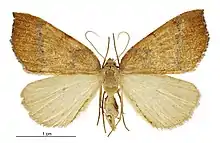Sestra humeraria
Sestra humeraria, also known as huarau looper, is a species of moth in the family Geometridae.[3] It was described by Francis Walker in 1861.[2] This species is endemic to New Zealand.[1]
| Sestra humeraria | |
|---|---|
 | |
| Male | |
 | |
| Female | |
| Scientific classification | |
| Kingdom: | |
| Phylum: | |
| Subphylum: | |
| Class: | |
| Order: | |
| Family: | |
| Subfamily: | |
| Genus: | |
| Species: | S. humeraria |
| Binomial name | |
| Sestra humeraria | |
| Synonyms[2] | |
| |
Description
The mature larva of this species has a slightly knobbly appearance with a pale brown body marked with darker wavy lines.[4] It is between 25 and 30 mm in length.[4]
Behaviour
When the larvae are touched they drop down to the soil or leaf litter.[4] The larvae can be seen all year but the adult moths are on the wing from October to December.[4]
Host
The larval host of this species is the fern Hypolepis millefolium.[4] The larvae feed on the fronds of their host.[4]
References
Wikimedia Commons has media related to Sestra humeraria.
- "Sestra humeraria (Walker, 1861)". www.nzor.org.nz. Landcare Research New Zealand Ltd. Retrieved 4 February 2018.
- Dugdale, J. S. (1988). "Lepidoptera - annotated catalogue, and keys to family-group taxa" (PDF). Fauna of New Zealand. 14: 169. Retrieved 4 February 2018.
- Gordon, Dennis P., ed. (2010). New Zealand inventory of biodiversity: Kingdom animalia : chaetognatha, ecdysozoa, ichnofossils. Vol. 2. p. 458. ISBN 978-1-877257-93-3. OCLC 973607714. OL 25288394M. Wikidata Q45922947.
- Andrew Crowe (2004). Life-Size Guide to New Zealand Native Ferns: Featuring the unique caterpillars which feed on them. p. 25. ISBN 0-14-301924-4. Wikidata Q115211440.
This article is issued from Wikipedia. The text is licensed under Creative Commons - Attribution - Sharealike. Additional terms may apply for the media files.